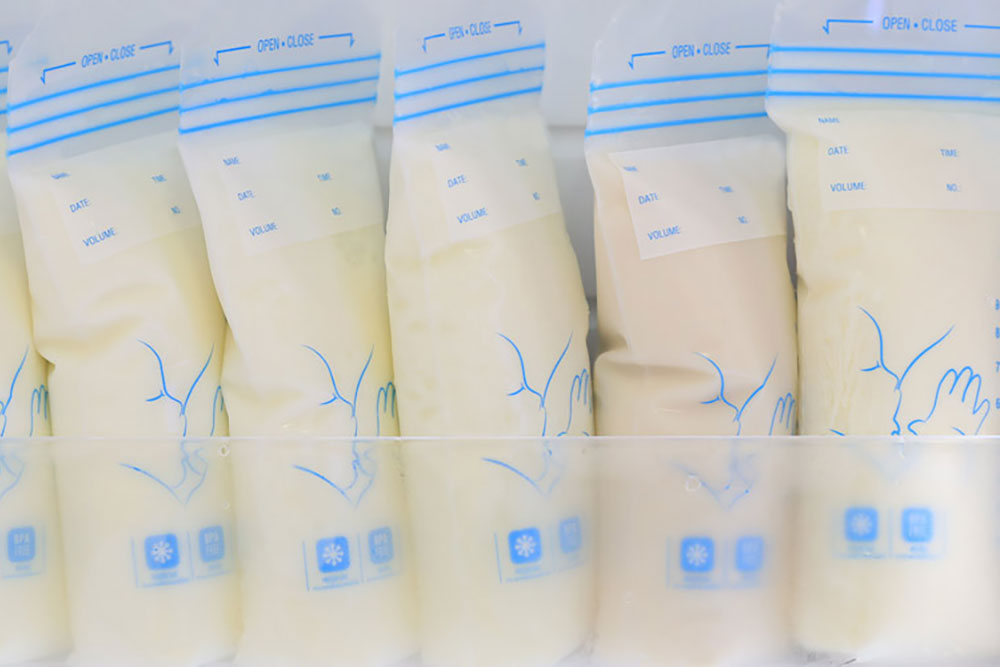Should Breastfeeding Parents Be Concerned About “Forever Chemicals” in Breast Milk?

These substances could come with adverse health effects. Here’s what parents need to know.
Medical Expert: Jenelle Ferry, MD
Polyfluoroalkyl substances (PFAS, also known as “forever chemicals”) are a large, complex group of synthetic chemicals that are found in many everyday products, such as food packaging, personal care products, stain-resistant coatings, nonstick cookware, and cleaning products.
While PFAS help to enhance certain products—for example, making firefighting foam inside an extinguisher more effective at quelling flames—their strong molecular bonds do not degrade quickly in the environment. Many of these chemicals are toxic and bioaccumulate in the food chain, as well as within the human body. This means that we’re not only coming in contact with a lot of these chemicals regularly but that they’re hard to get rid of, too.
According to the Environmental Protection Agency (EPA), there is evidence that exposure to PFAS may lead to adverse human health effects, including cancers, reproductive issues, weakened childhood immunity, low birth weight, endocrine disruption, increased cholesterol, weight gain in children and adults, and more. Certain PFAS are no longer manufactured in the United States as a result of the 2010/2015 phase-out programs, which resulted in eight major chemical manufacturers agreeing to eliminate the use of perfluorooctanoic acid (PFOA) and PFOA-related chemicals in their products and emissions from their facilities. However, even though PFOA and PFOS are no longer manufactured domestically, they are still produced internationally and can be imported into the United States.
While PFAS have been a topic of conversation for years, the concern made headway after a study in Seattle showed 100% of collected breast milk samples contained pre- and current-PFAS, alarming researchers with the potential levels of exposure in newborns.
Unfortunately, PFAS contamination is very common and also hard to avoid. In addition to being found in many everyday items, forever chemicals are also found in groundwater, which can eventually impact localized drinking water. It’s estimated that more than 200 million people—the majority of Americans—have tap water contaminated with PFAS. With so many opportunities for exposure to these substances, breastfeeding parents may be questioning what’s safe when it comes to nursing and how to best protect their children.
To better understand how this impacts the health of mother and baby, we connected with Jenelle Ferry, MD, a neonatologist at Pediatrix Medical Group of Tampa, Florida for an important Q&A.
Q: Do PFAS Remain in Human Breast Milk and Transfer to Newborns?
A: PFAS are man-made chemicals engineered to be extremely resistant to degradation, and therefore can accumulate and persist in animal and human tissues for years. They can be found in the blood of almost every person worldwide, and concentrations have wide geographic ranges. A human body’s exposure begins as a fetus, as these molecules can cross the placenta. They can also be found in breast milk and therefore transferred to newborns.

Q: What Health Effects Do These Chemicals Have on a Baby?
A: It is difficult to show if these substances can directly cause any human health problems. Any real or potential effects seem to be after many years of exposure and build up over time. Studies in humans have not consistently shown an association with neurodevelopment, ADHD, cancer, thyroid, kidney, or metabolic disease. However, there is a potential association with high cholesterol. Additionally, there does seem to be a link between high levels of PFAS and a slightly lower fetal growth rate due to exposure through the placenta. It is unclear if exposure in infancy (via breast milk) and later childhood (via food and water) also affects growth, with the potential for increased [obesity] later in life. Significant effects of environmental toxins on nursing infants have only been seen in cases where the birth parent had a sufficiently large exposure to be ill/toxic themselves.
Q: Are Forever Chemicals a Medical Concern to Those Who Are Breastfeeding?
A: There was a change in manufacturing processing in the early 2000s, which resulted in shorter-chain PFAS now being produced (meaning they break down more quickly). These are also constantly changing, and methods for detecting them have a hard time keeping up. Less is known about long-term exposure to newer PFAS; few studies have suggested they are less persistent. On a positive note, except for some concentrated contamination sites, most studies of PFAS in humans have reported concentrations well below any predicted effect.
Q: Can Breastfeeding People Get Tested to See if Their Milk Registers at a High Level for Contamination?
A: If you have concerns about high levels of PFAS in your environment, you should talk to your doctor. Testing for PFAS is expensive and not routine but has been conducted in areas with suspected higher concentrations, especially via water contamination. Testing is usually performed on blood. Surveillance studies have shown a wide range of levels in breast milk, and there are no published records of reference ranges. This makes testing levels in breast milk very difficult to interpret. Knowing PFAS are present can leave someone with insufficient information to make an informed decision about continuing to breastfeed.
Q: Should Someone Reconsider Breastfeeding Because of Forever Chemicals?
A: In almost all cases, the answer is to continue breastfeeding [if desired]. The benefits of breastfeeding far outweigh the potential, and likely small, negative effects of PFAS. Breastfeeding conveys benefits for the infant (decreased obesity, ear and respiratory infections, sudden infant death syndrome) as well as the mother (decreased risk of high blood pressure, Type 2 diabetes, and breast and ovarian cancers).
Additionally, as knowledge of the presence of PFAS in our environment and diet is relatively new, most recent studies have focused on validating methods to quantify the presence of these environmental toxins in food products and milk, including human milk and infant formulas. While the presence of PFAS has been confirmed in breast milk, it is important to note that these substances are also found in cow’s milk products, including infant formula.
While further data is collected about the long-term health implications of these substances accumulating in our environment, the presence of human milk alone should not dissuade a parent from deciding to provide human milk to their infant. The Centers for Disease Control and Prevention (CDC) as well as the American Academy of Pediatrics (AAP) strongly recommend the continuation of breastfeeding. The AAP states “even though a number of environmental pollutants readily pass to the infant through human milk, the advantages of breastfeeding continue to greatly outweigh the potential risks in nearly every circumstance.”
Q: How Can You Limit Exposure to PFAS and Minimize the Risk of Transferring Them to Your Baby?
A: PFAS can be found in soil, water, and air. The main source of transmission to humans is via water sources and diet. Mothers can check with their local health department to see if the levels in their water supply are known and at an advisory level.
You can check with your local or state health and environmental quality departments for fish advisories. Additionally, PFAS chemicals are used in some food packaging containers, such as takeout containers and pizza boxes.
There is insufficient data to make any single recommendation for limiting exposure. In terms of breastfeeding, it is important that a breastfeeding parent maintain a healthy, balanced diet and weight, which will benefit the quality of their breast milk in many ways. This may help decrease PFAS, as there have been observations of higher PFAS levels with increasing obesity, and a balanced diet with limited takeout may decrease toxicity exposure from food packaging materials. Finally, granular activated carbon water filtration systems may decrease toxic chemicals in water levels, though this can be costly and is not entirely proven.
As a parent, trying to navigate the many dangers to your child—real, potential, big, and small—can certainly be overwhelming. The reality regarding PFAS is there is so much we just don’t know from an environmental health standpoint. The most important thing a parent can do for their newborn is to provide good nutrition for a healthy immune system and the best future health foundation, which includes breastfeeding if and whenever possible.








